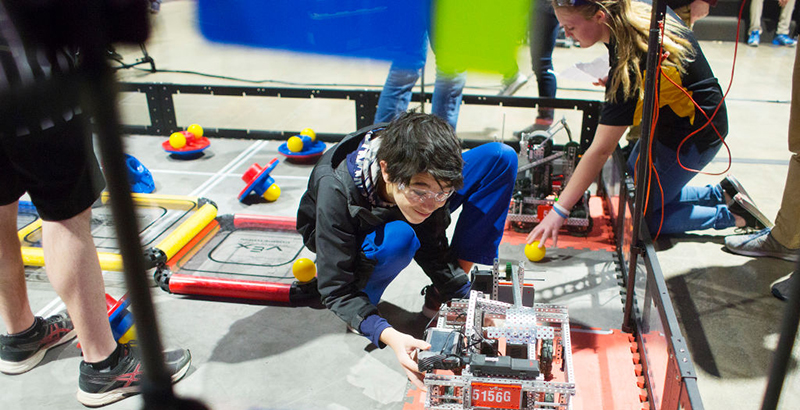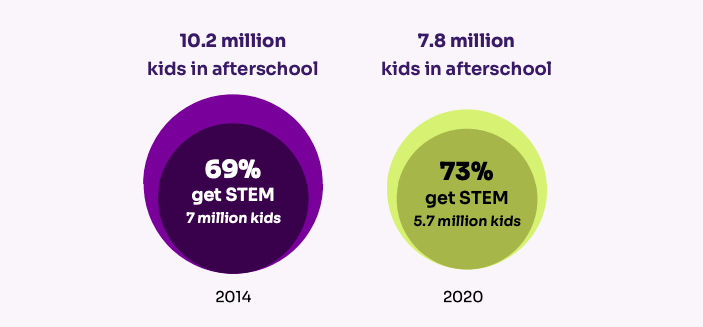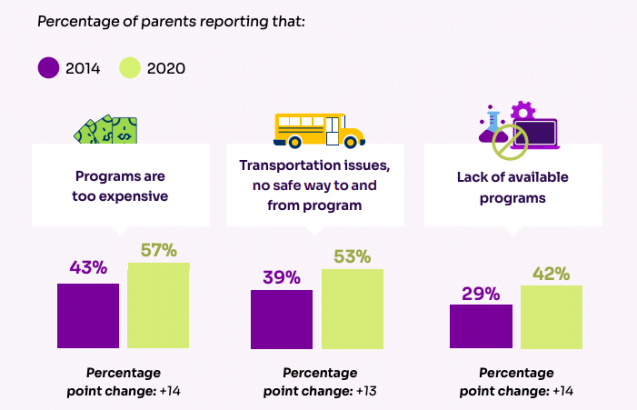‘We Left Those Students Behind’: 1.9 Million Low-Income Youth Boxed Out of Afterschool Programs, Despite Surging Parent Interest in STEM Offerings

Get stories like this delivered straight to your inbox. Sign up for The 74 Newsletter
Every year, millions of students nationwide participate in afterschool and summer programs that help them gain skills in science, technology, engineering and math — also known as STEM. But even as student interest surges and the programs continue to expand, financial and transportation barriers have boxed many young people out of these pivotal learning opportunities, particularly students from low-income families, a new report reveals.
From 2014 to early 2020, just before the pandemic, the U.S. saw a 1.3 million-student drop in afterschool STEM participation, falling from 7 million learners to 5.7 million, according to the paper, which was published by the nonprofit organization Afterschool Alliance.
Those drops were starkest among poorer students, who were already underrepresented in STEM fields. In that timespan, the number of young people from low-income households participating in afterschool programs, STEM or otherwise, fell from 4.6 million to 2.7 million — meaning 79 percent of afterschool attrition came from less wealthy families despite such students making up only 38 percent of all participants in 2020.
“We left those students behind,” said Nikole Collins-Puri, CEO of the California-based nonprofit Techbridge Girls.
Simultaneously, however, the share of afterschool programs offering STEM opportunities grew. Nearly 3 in 4 young people learning outside of school hours have science and technology programming available to them. That’s up four percentage points from 69 percent in 2014.
“The inequities are troubling and must not continue,” said Jodi Grant, Afterschool Alliance’s executive director, in a press release. “We need to increase access to afterschool overall, because even though parents report a greater percentage of programs are providing STEM, fewer children are in afterschool programs today than in years past.”

Data for the report come from a randomly selected, nationally representative sample of U.S. families, including a total of more than 31,000 phone interviews, making the report the most comprehensive look at out-of-school learning to date.
The interviews revealed that, even amid drops in afterschool program participation, more parents than ever before would like to see their children get involved in such opportunities. For every child in an out-of-school learning program, another three are waiting to get in, according to the study. The parents of some 24.6 million students said they would enroll their child in afterschool programming if the offerings were readily available to them.
Cost and transportation appear to pose key barriers. Fifty-seven percent of parents said afterschool opportunities were too expensive and 53 percent said they weren’t sure how their kids would get to and from activities. STEM programs may be particularly pricey, with a $107 mean weekly reported price, compared to $74 per week for other offerings.

Despite barriers, however, science and math opportunities are an increasing priority for parents. Some 72 percent of families, up from 53 percent in 2014, told researchers that STEM and computer science learning were important factors in their selection of afterschool and summer programs. Rates were especially high among Black, Hispanic and Asian families.
STEM-related occupations tend to be more lucrative than non-STEM fields, and the U.S. Bureau of Labor Statistics predicts the former will grow by 8 percent in the next decade, while the latter will only grow 3.4 percent. STEM fields, however, tend to employ a more white and more male workforce than the general population.
Collins-Puri’s organization, Techbridge Girls, works to counter that trend by providing STEM learning opportunities to low-income girls of color and gender-expansive individuals.
Widening access to STEM programs, she said in a briefing held on the Afterschool Alliance report, means eliminating potential barriers to participation for underrepresented groups. For example, young women more so than young men tend to shoulder caregiving responsibilities, the CEO pointed out — which for many families only increased during the pandemic.
“When girls have the responsibility to take care of their younger sibling, to take care of their elderly family members, or even take on some of the economic responsibilities to support the household, that is a direct impact to their participation in afterschool programming,” said Collins-Puri.
“You have to make your afterschool programming flexible,” she continued. Adults should encourage students to come to activities, regardless of their home responsibilities, by telling them, “Make sure you bring your younger sibling so they can be part of the learning experience,” the Oakland afterschool leader advised.

Programs may soon have additional resources at their disposal, Grant, of the Afterschool Alliance, pointed out thanks to funds from the American Rescue Plan, which could allow some organizations to subsidize program costs, bolster transportation options or make other adjustments to meet families’ needs.
Even amid persistent disparities in access to afterschool programming, gaps have never been due to any deficiencies among individuals who belong to underrepresented groups, Collins-Puri reminded viewers.
“Our girls lack nothing. Our girls are capable. They’re ready and they’re willing to be in the STEM revolution.”
Get stories like these delivered straight to your inbox. Sign up for The 74 Newsletter

;)
